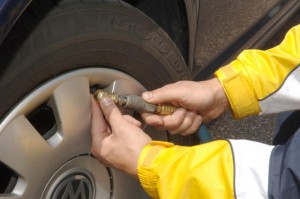Get better gas mileage — 10 Tips To Get More MPG
Use these 10 tips to get better gas mileage
Here’s a comprehensive list of top 10 ways to get better gas mileage in your vehicle without taking it to the shop.
 Keep your tires inflated to the pressure listed on the label inside the driver’s door pillar.
Keep your tires inflated to the pressure listed on the label inside the driver’s door pillar.
Most drivers never check their tire pressure, and that can cost you at the pump. An underinflated tire deflects more energy, increasing rolling resistance, which robs the vehicle of fuel efficiency. Tires lose pressure over time and running a tire 20 percent underinflated, which is 5 to 7 psi below the recommended pressure can increase your fuel consumption by 10 percent.
What’s that in terms of dollars? Underinflation costs you 2-3 miles per gallon, or .27/gallon to .41/gallon (gasoline price $2.75 and 20MPG).
Not only that, but “running underinflated also reduces the tire’s tread life,” said Bob Toth, Goodyear’s general manager, auto tires.
If that’s not enough, the Society of Automotive Engineers reports that 87 percent of all flat tires have a history of underinflation.
Replace spark plugs early to get better gas mileage
Not all engines can go 100K miles on spark plugs. Some engines, especially engines with turbochargers require spark plug changes at 30K, 40K or even 60K miles; even with expensive iridium spark plugs. Why? Because most modern engines run extremely lean and that causes high combustion temperatures that degrade the spark plug electrodes faster than in cars from the 70’s through 2000 model years. In addition, C.O.P. ignition coils allow the spark plugs to fire at much higher voltages.
Lose some weight
Do you really need to haul all that extra junk in your trunk. Clean out your car and trunk and you’ll reduce vehicle weight and increase gas mileage.
Lighten up on the pedal to increase gas mileage
It’s not a race and putting the pedal to the metal costs you big time. Less aggressive acceleration reduces fuel consumption. You’ve heard a hundred times, now do it.
Use the correct motor oil
Think you know more than the engineers that designed your engine? Think again. Adding a heavier weight oil increase friction in your engine, causing it to run hotter and less efficiently. The lighter weight oil in recommended for late model engines actually saves gas.
Use cruise control to get better gas mileage
Steady acceleration saves gas.
Reduce electrical loads
That bitchin’ sound system you added gulps power. Power isn’t free. Turn off heated seats, heated mirrors, rear window defogger and reduce blower motor speed as soon as you’re comfortable.
Use your AC instead of driving at high speeds with your windows open
The aerodynamic drag caused by open windows at highway speeds costs you more than the cost of running your AC. At city speeds, the opposite is true. If you can handle the temperature, turn off your AC and open your windows when driving at less than 40-MPH.
Don’t warm up your engine in cold weather
Warming your engine in cold weather wastes gas. Start your engine. Buckle your seat belt. Turn on the defroster. Check for traffic. Then DRIVE. That heats up your engine much faster than letting it idle and that uses LESS gas.
Combine trips to save gas
Warming up a cold engine takes a lot of energy. Once it’s warm, run as many errands as possible, especially in cold weather. You’ll save gas.
© 2012 Rick Muscoplat
Posted on by Rick Muscoplat